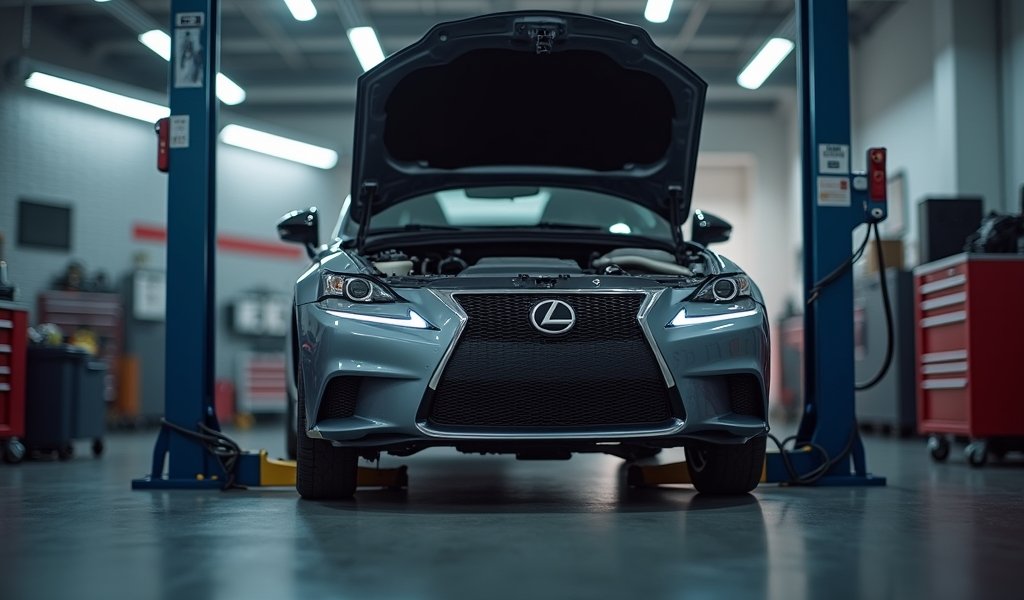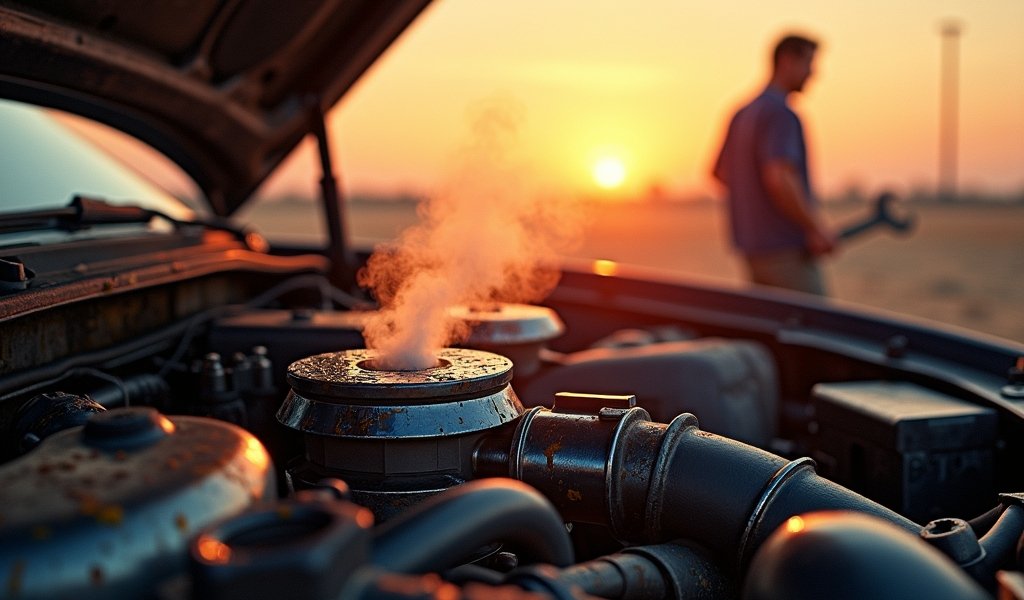Overview
The article explains five fixes for expansion tank pressure cap issues: replacing worn gaskets, cleaning mineral deposits, adjusting pressure settings, fixing leaks, and complete cap replacement. These maintenance steps are crucial as the pressure cap regulates cooling system pressure, prevents engine overheating, and raises coolant boiling points, with regular inspection recommended to avoid costly engine damage.
Table of Contents
- Understanding Expansion Tank Pressure Caps
- Signs of Pressure Cap Problems
- Fix #1: Replacing Worn Gaskets
- Fix #2: Cleaning Mineral Deposits
- Fix #3: Adjusting Pressure Settings
- Fix #4: Fixing Leaks
- Fix #5: Complete Cap Replacement
- Preventative Maintenance
- Conclusion
- Frequently Asked Questions
Understanding Expansion Tank Pressure Caps
That little cap on your vehicle’s expansion tank does a mighty big job. As a mechanic with 20 years under my belt, I’ve seen how this humble component can make or break your cooling system. The expansion tank pressure cap isn’t just a lid—it’s a precisely calibrated valve that maintains your cooling system at the perfect pressure.
When your engine heats up, coolant expands. Without somewhere to go, this expansion would create dangerous pressure levels that could rupture hoses or damage your radiator. Your expansion tank gives that expanding fluid a place to go, while the pressure cap ensures the system maintains optimal pressure—typically between 13 and 16 PSI depending on your vehicle.
Think of it as a safety valve. It’s designed to release excess pressure when things get too hot under the hood, then pull coolant back into the radiator as the system cools down. This simple function prevents engine overheating issues that could leave you stranded on the roadside.
The pressure cap also raises the boiling point of your coolant. Water normally boils at 212°F (100°C), but under pressure, that boiling point increases significantly—allowing your cooling system to operate efficiently at higher temperatures. According to Engineering ToolBox, every 1 PSI of pressure raises water’s boiling point by about 3°F.
Signs of Pressure Cap Problems
How do you know when your expansion tank pressure cap is crying out for help? First, watch for coolant leaks around the cap area. If you spot green, orange, or pink fluid residue around the cap, something’s not sealing properly.
An overheating engine might be telling you the pressure cap isn’t maintaining proper system pressure. When the cap fails, your coolant might boil at lower temperatures, reducing the system’s cooling efficiency.
Listen for unusual sounds too. A hissing noise when you shut off your engine could indicate pressure escaping around a failing cap. You might also notice your coolant reservoir level dropping without any visible leaks—a sign that your cap isn’t creating the vacuum needed to pull coolant back into the system as it cools.
Swollen radiator hoses are another telltale sign. When I’m performing a routine radiator hose inspection, overly firm or expanded hoses often point to excessive system pressure from a faulty cap.

Fix #1: Replacing Worn Gaskets
The rubber gasket on your pressure cap is often the first component to fail. Heat, pressure, and coolant chemicals gradually break down the rubber, causing it to crack, flatten, or become brittle. When this happens, your once-tight seal becomes a pressure leak waiting to happen.
Replacing a worn gasket is one of the easiest and most cost-effective fixes for pressure cap issues. Here’s my step-by-step approach:
- Wait until your engine is completely cool—I can’t stress this enough for safety!
- Carefully remove the pressure cap by pressing down and turning counterclockwise.
- Examine the rubber gasket for cracks, deformation, or hardening.
- If damaged, purchase a replacement gasket specific to your cap model.
- Remove the old gasket by gently prying it away from the cap.
- Clean the cap thoroughly to remove any debris or old rubber residue.
- Install the new gasket, ensuring it sits properly in its groove.
- Reinstall the cap and hand-tighten only.
You’ll need few tools for this job—just clean rags and possibly a small flathead screwdriver to help remove the old gasket. The replacement gasket itself typically costs between $5-15, making this fix incredibly economical compared to the potential consequences of ignoring the problem.
After replacement, start your vehicle and let it reach operating temperature. Check for leaks around the cap and monitor your temperature gauge to confirm normal operation.
Fix #2: Cleaning Mineral Deposits
Over time, mineral deposits from your coolant can build up on your pressure cap’s valves and sealing surfaces. These crusty deposits are like plaque in arteries—they prevent proper operation by keeping valves from seating correctly or interfering with the spring mechanism.
I’ve rescued countless pressure caps from the scrap heap with a good cleaning. Here’s my tried-and-true method:
- Remove the cap (engine cool, remember?) and inspect for whitish, yellowish, or rusty deposits.
- Soak the cap in a solution of equal parts white vinegar and water for 1-2 hours.
- Use an old toothbrush to gently scrub away loosened deposits, paying special attention to valve seats and springs.
- Rinse thoroughly with clean water.
- Dry completely before reinstalling.
For stubborn deposits, commercial lime and scale removers work well, but be sure to rinse thoroughly afterward. These products can be harsh on rubber components if left in contact too long.
This cleaning process not only extends your cap’s life but also ensures it functions properly. The spring inside the cap needs to move freely to regulate pressure correctly—mineral buildup can restrict this movement, causing pressure regulation failures.
I typically recommend cleaning your cap annually or whenever you flush your cooling system. It’s a preventative measure that costs virtually nothing but can save you from overheating headaches down the road.
Fix #3: Adjusting Pressure Settings
Some expansion tank pressure caps have adjustable settings, though this is more common in industrial applications than passenger vehicles. If you have an adjustable cap, ensuring it’s set correctly is crucial for proper system operation.
First, you’ll need to know the correct pressure specification for your vehicle. This information is typically found in your owner’s manual or service manual. Most passenger vehicles run between 13-16 PSI, but there can be variations based on manufacturer specifications.
To adjust an adjustable pressure cap:
- Locate the adjustment mechanism, usually at the top of the cap.
- Use a pressure gauge to verify the current setting.
- Turn the adjustment clockwise to increase pressure or counterclockwise to decrease.
- Retest with your pressure gauge to confirm the new setting.
Be aware that most consumer vehicles use fixed-pressure caps that aren’t designed to be adjusted. In these cases, if you need a different pressure rating, you’ll need to purchase a new cap with the desired pressure rating.
Setting your cap too high can cause damage to hoses, seals, and even your radiator. Too low, and your coolant may boil prematurely, leading to overheating. The engine coolant temperature sensor can alert you to overheating conditions, but prevention is always better than cure.
If you’re unsure about the correct pressure for your system, consult a professional mechanic or your vehicle manufacturer. This isn’t a setting to guess at—precision matters here.

Fix #4: Fixing Leaks
Leaks around your expansion tank pressure cap can stem from several sources. The cap itself might be the culprit, but don’t overlook the expansion tank neck or the threads where the cap screws in.
If you’ve confirmed the cap and gasket are in good condition but still see leakage, inspect the expansion tank neck for cracks or damage. Small cracks can sometimes be repaired with epoxy designed for plastic repair, but this is often a temporary fix. For metal tanks, check for corrosion that might prevent proper sealing.
When the threads on the tank neck are damaged:
- Clean the threads thoroughly using a wire brush to remove any debris.
- Apply a small amount of thread sealant designed for cooling systems.
- Install the cap carefully to avoid cross-threading.
- Hand-tighten only—excessive force can damage the tank or cap.
If your expansion tank has a seam leak or significant crack, it’s generally best to replace the entire tank. Modern plastic tanks aren’t designed for major repairs, and a failed repair could leave you with a more significant problem at the worst possible time.
According to the National Highway Traffic Safety Administration, cooling system failures account for a significant number of vehicle breakdowns. A small investment in fixing these leaks properly can prevent more costly repairs and roadside emergencies.
Fix #5: Complete Cap Replacement
Sometimes, the simplest solution is the best one. If your pressure cap is old, damaged, or just not functioning properly despite your best efforts, replacement is the most reliable fix. Most caps cost between $10-30, making this a budget-friendly repair that delivers significant peace of mind.
When selecting a replacement cap, matching the pressure rating is crucial. This information is usually stamped on the top or side of your current cap (something like “13 PSI” or “0.9 BAR”). Using a cap with too high or too low pressure can cause serious cooling system issues.
Here’s my process for replacing an expansion tank pressure cap:
- Wait until the engine is completely cool.
- Remove the old cap by pressing down and turning counterclockwise.
- Compare the old cap with your replacement to ensure proper fitment.
- Check that the pressure rating matches manufacturer specifications.
- Inspect the tank neck for any debris and clean if necessary.
- Install the new cap and hand-tighten only.
- Start the engine and check for proper operation.
After replacement, monitor your cooling system for a few days to ensure everything functions correctly. Check coolant levels and watch your temperature gauge for any signs of improper operation.
One important note: some vehicles require specific cap designs that might look similar but function differently. Always consult your owner’s manual or a trusted parts specialist to ensure you’re getting the correct cap for your specific vehicle model.
The peace of mind that comes from a properly functioning cooling system is well worth this small investment. As Gates Corporation experts note, the cooling system operates under significant stress and having reliable components is essential for long-term engine health.
Preventative Maintenance
An ounce of prevention is worth a gallon of coolant on the highway. Regular preventative maintenance of your expansion tank pressure cap can save you from unexpected breakdowns and costly repairs.
I recommend inspecting your pressure cap every time you check your fluid levels—about once a month for most drivers. Look for signs of damage, corrosion, or deterioration of the rubber gasket. A quick visual inspection takes seconds but can identify problems before they leave you stranded.
When performing your seasonal maintenance:
- Remove and clean your pressure cap thoroughly.
- Inspect the springs and valves for proper operation.
- Check the gasket for signs of wear or deterioration.
- Test the cap with a pressure tester if you have access to one.
- Clean the tank neck to ensure a proper seal.
Most professional mechanics recommend replacing your pressure cap every two years as preventative maintenance, even if it appears to be functioning correctly. The internal components wear over time, and failure can occur without visible external signs.
If you live in an area with extreme temperatures, consider upgrading to a high-quality OEM or premium aftermarket cap. These caps typically have better materials and more precise pressure regulation, which can extend the life of your entire cooling system.
Conclusion
Your expansion tank pressure cap might be small, but its role in your vehicle’s health is mighty. Whether you’re replacing worn gaskets, cleaning mineral deposits, adjusting pressure settings, fixing leaks, or installing a complete replacement, maintaining this critical component will help keep your engine running cool and reliable for years to come.
Remember that cooling system issues should never be ignored. That small cap is all that stands between your engine and potential overheating damage that could cost thousands to repair. The fixes we’ve covered are all relatively simple and inexpensive—especially compared to the alternative of major engine repairs.
For most drivers, regularly inspecting your expansion tank pressure cap and replacing it every couple of years is sufficient preventative maintenance. But if you notice any signs of cooling system issues—overheating, coolant loss, or leaks—don’t hesitate to check your cap first. It’s often the simplest solution to what might seem like a complex problem.
Keep your cool on the road by keeping your cooling system in top condition. Your engine—and your wallet—will thank you.
Frequently Asked Questions
How do I know if my expansion tank pressure cap is bad?
Look for coolant leaks around the cap, an overheating engine, or coolant reservoir level changes. You might also notice swollen radiator hoses or hear hissing sounds when shutting off your engine.
What happens if I use the wrong pressure cap?
A cap with too low pressure can cause premature coolant boiling and engine overheating. A cap with too high pressure might damage hoses, seals, or even your radiator.
How often should I replace my expansion tank pressure cap?
Most professional mechanics recommend replacement every two years as preventative maintenance. Replace immediately if you notice any signs of damage or cooling system issues.
Can I drive with a faulty pressure cap?
It’s not recommended as it can lead to engine overheating and potentially serious engine damage. A replacement cap is inexpensive compared to the potential repair costs from driving with a faulty one.
Does the pressure cap affect fuel efficiency?
Yes, indirectly. A properly functioning cooling system keeps your engine at optimal operating temperature, which improves combustion efficiency and fuel economy.

